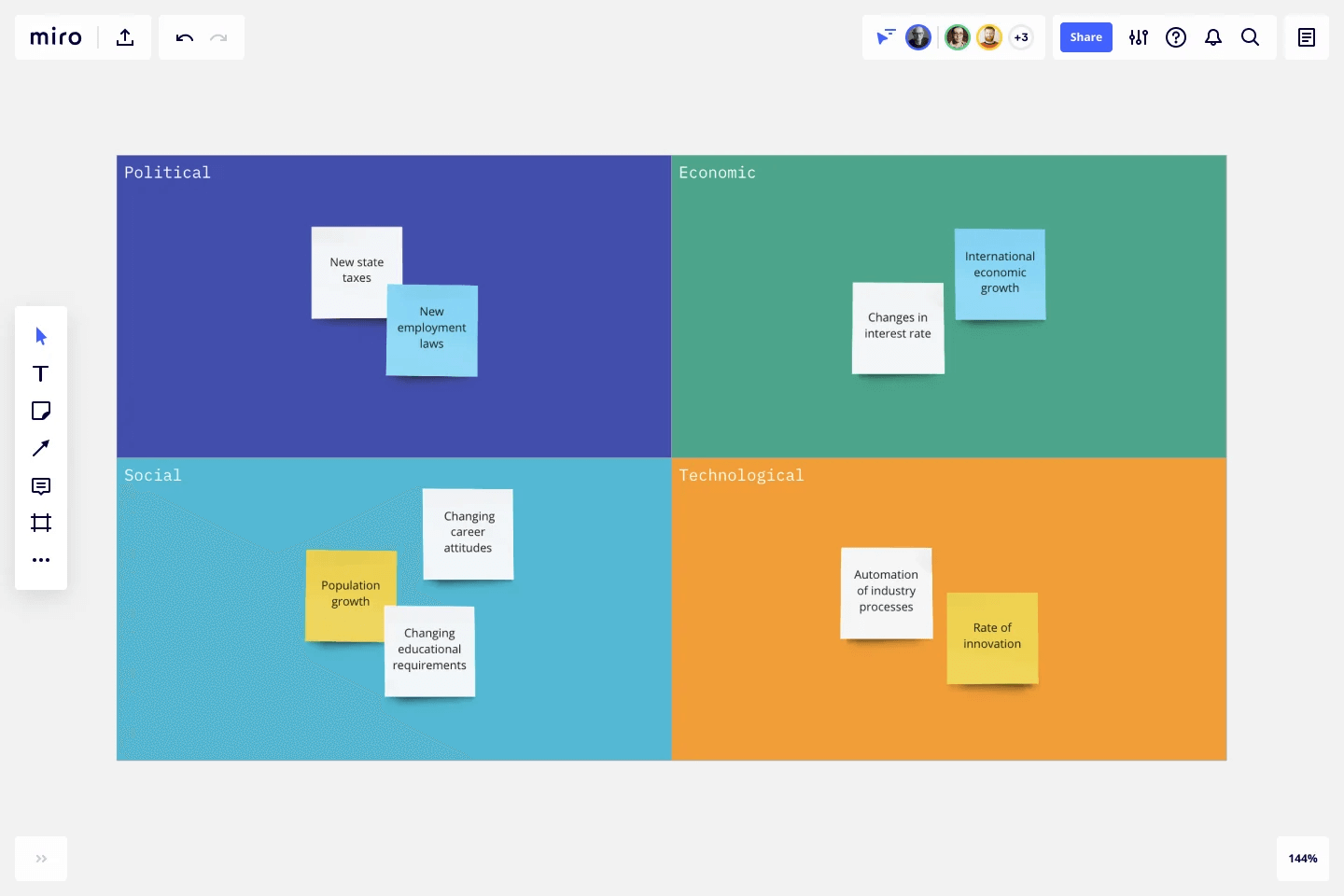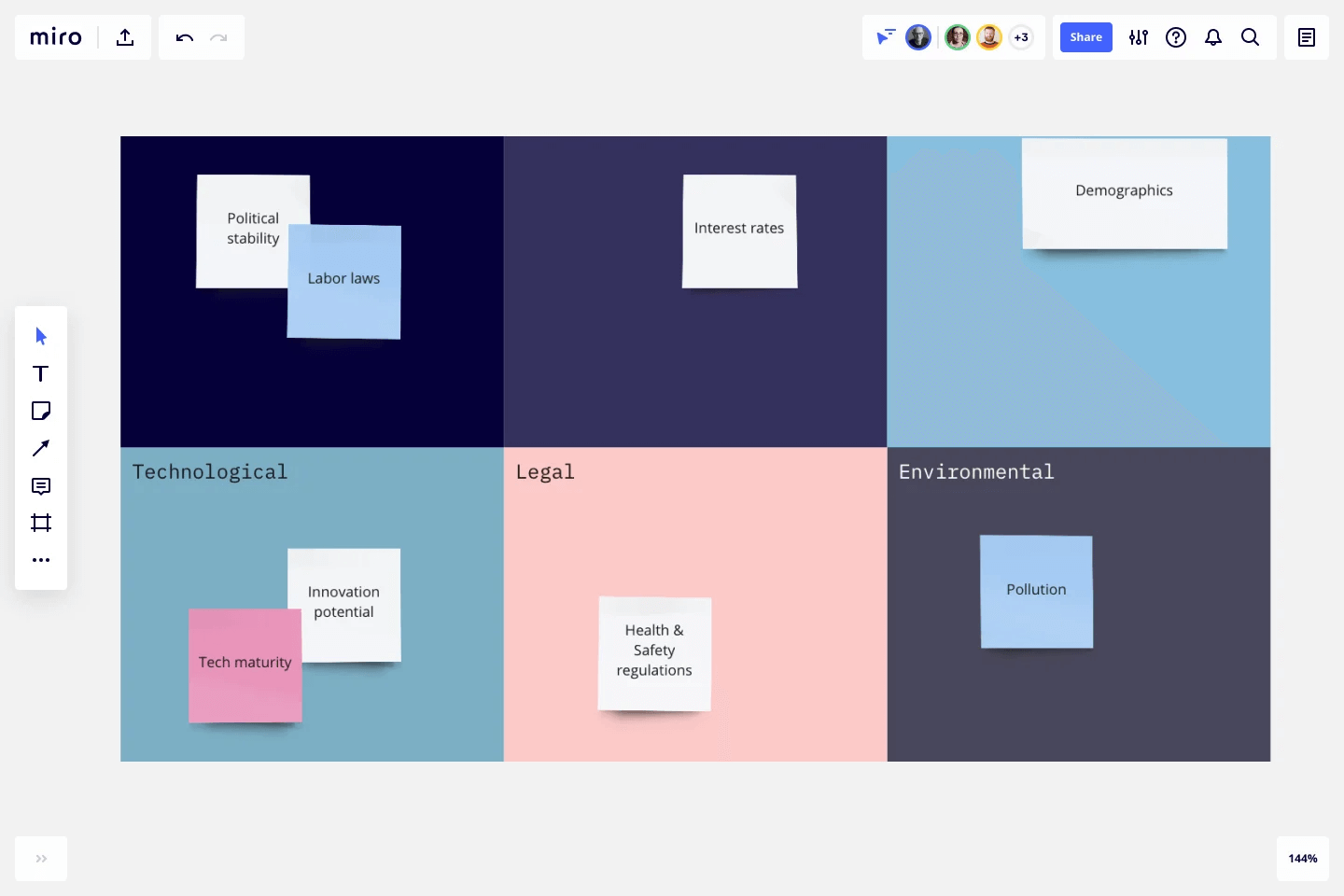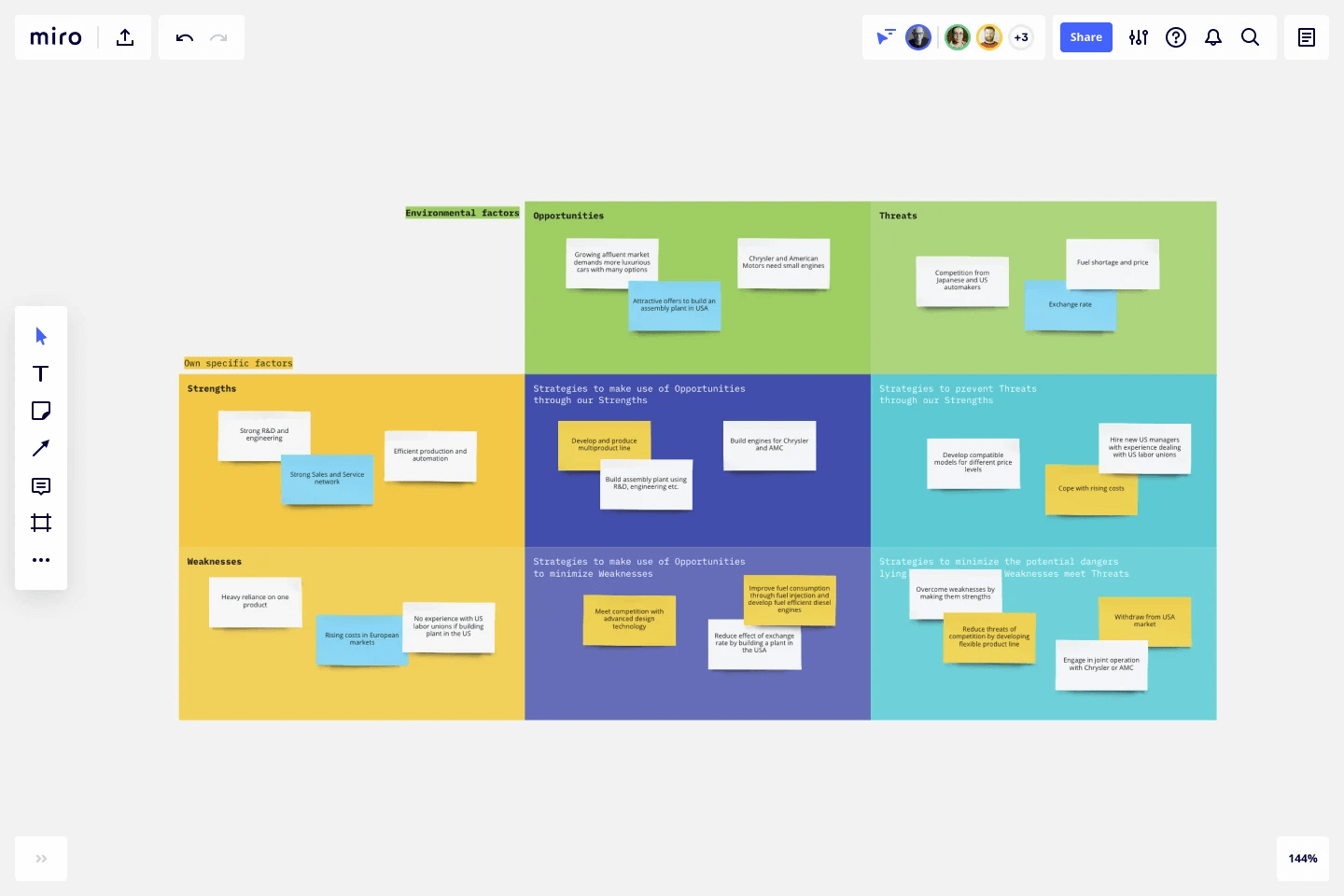Sometimes coming up with an idea for the next big thing is the easy part. But, how do you take that moment of inspiration and corral it into something tangible that creates business success?
What other things do you need to be keeping an eye on that can influence whether your product or service is a flop or a flyer in a particular market?
This article introduces PEST analysis and explains why this environmental scanning framework helps you brainstorm the factors that influence where and how you decide to grow your business.
Try Miro’s Pest Analysis Template
What is PEST analysis in business?
PEST analysis is a way of identifying external factors that affect your business and then quantifying the impact of those factors.
PEST is an acronym that stands for Political, Economic, Social, and Technological.
Government policies, such as taxation, building regulations, and employee rights, are examples of political factors.
Economic factors might include the stability of the current economy, unemployment levels, and exchange rates.
When considering social factors, businesses might want to include the population growth rate, age distribution, social taboos, or religious beliefs pertaining to the specific market.
And, finally, technological factors may include any new technologies that businesses can exploit and how technological change is shifting social-cultural attitudes, such as the growth of remote working.

Harvard professor Francis Aguilar created the PEST analysis model in the 1960s, and it’s still a valuable part of the strategic planning process of businesses today.
People sometimes expand on the PEST model to include additional factors.
For example, the PESTLE analysis model includes the addition of legal and environmental aspects, and the STEEPLE model adds ethical factors on top of that. A PEST analysis is valuable because it provides a strategic-level snapshot of how various macro-environmental factors might impact current and future operations.
Through undertaking a PEST analysis, organizations can identify, evaluate, and monitor these factors and use their analysis to improve decision-making in critical areas, such as:
- Strategic planning, including opportunities for partnership and growth
- Budget and resource allocation
- Capability planning, including key talent requirements for the future
- Technological investments

When would you conduct a PEST analysis?
So, now you’re clear on what a PEST analysis is, but when exactly should you use it?
The most straightforward answer is whenever you need more information on your external environment. This could be when you’re initially establishing a new business or if you’re considering changing direction in your current business.
A PEST analysis may form part of the annual strategic planning process, or you could undertake an ad-hoc analysis if you’re aware of upcoming changes to the macro environment and want to re-evaluate the market.
You might choose to conduct a PEST analysis if you’re considering growing your business or a potential partnership, merger, or acquisition opportunity.
You may also conduct one because a particular strategic approach is less successful than you thought, and you want to know why.
According to the Ansoff matrix — a marketing planning tool that guides businesses in their product and market growth strategies — there are four ways a business can expand:
- Market development: Entering a new market with the same products
- Product development: Launching a new product in the same market
- Market penetration: Increasing sales in an existing market
- Diversification: Creating new products in new markets
A PEST analysis is an important market research tool and can provide useful insight into which of these strategies may be most appropriate for your organization.

What factors should each category consider?
Let’s consider an example. Say you’re a car manufacturer considering bringing a new electric car to your current market. Your product development PEST analysis might look like this:
Political:
- The government policy is looking to reduce petrol car ownership to less than 50% over the next ten years
- There’s a government subsidy of $5,000 for every hybrid or electric car purchase
- There’s an emissions tax exemption for electric vehicles
- A newly signed 20-year agreement with the Middle East has secured the oil supply chain
Economic:
- The inflation rate is currently low but predicted to rise over the next 12 months
- Electricity supply is stable but expensive
Social:
- The trend for environmentally friendly purchasing is increasing and supported by several celebrity influencers
- Younger buyers entering the market want cleaner cars
- People see electric cars as a status symbol in urban areas
Technological:
- There is limited infrastructure, and the growth of national battery-charging stations has been slow
- Battery technology is relatively static and unlikely to lead to faster-charging batteries in the near future
- Charging stations in the residential housing market are becoming more common
Depending on what strategy you were considering, you might also want to add in the environmental and legal factors of PESTLE or the ethical factors of STEEPLE.
For example, if you were considering the product development strategy of bringing an electric car to market, then identifying and analyzing the environmental factors would be important.
However, if you were considering a merger or acquisition opportunity, you’d want to look at legal factors. You might also want to look at the other company’s ethical position to ensure none of their practices will impact your business’s reputation.
What benefits can you expect from a PEST analysis?
Conducting a PEST analysis is essential to improve your understanding of the broader business environment in order to guide future strategy. A well-executed PEST analysis brings several benefits, including:
Improved strategic thinking
Going through the process of analyzing macro-environmental factors builds managers’ ability to think strategically about the importance of external issues outside the control of the business.
It also requires them to assess the impact of these factors and decide how to position the business given this information.
PEST, PESTLE, or STEEPLE analysis means you’re working based on facts rather than assumptions. They improve objectivity, which is vital for successful decision-making.

Improved visibility of threats and opportunities
Continuing on from above, a robust PEST analysis can highlight potential risks to your business’s operations.
For example, a change in government tax policy that increases import tax may significantly impact the cost and supply chain of your raw materials.
A PEST analysis would expose this potential threat, which means the business can anticipate the risk and discuss options to avoid or minimize its effect.
Of course, a PEST analysis may also help business leaders identify factors in the macro-environment that could provide a competitive advantage should the business have the capabilities to exploit them effectively. More on that below.
Straightforward and low-cost
The PEST analysis concept is pretty simple and easy to put into effect.
While it certainly requires some market research and the ability to identify trends at a macro-level, much of that is a bread-and-butter skill set for professional marketers and strategists.
And PEST analysis marketing is low-cost. The main outlay is in labor hours on research and analysis. Investing in a collaborative tool that enables the sharing, annotation, and analysis of the information could also be worthwhile.
How does PEST compare to SWOT?
People often link PEST analysis with SWOT analysis, but while the two are complementary, they’re not the same.
SWOT stands for Strengths, Weaknesses, Opportunities, and Threats, and it takes an internal — or micro — viewpoint as well as an external — or macro — one.
So, what similarities can you find between SWOT and PEST analysis?
Well, both are models that consider factors that affect strategic decision-making.
A PEST analysis assesses the attractiveness of a market by considering the ‘big picture’ factors affecting it.
A SWOT analysis assesses your business’s internal capabilities and its ability to exploit external opportunities and mitigate threats.
This assessment influences business strategy because even if a PEST analysis rates a market as particularly attractive, entering that market would be a poor decision if your business can’t exploit it.
You should always complete your PEST analysis before your SWOT analysis. This is because several factors you identify in your PEST analysis will likely become the opportunities and threats you identify in your SWOT analysis.
For example, consider a change in government policy that leads to deregulation in a new market you’re targeting. You might capture this as a political factor in your PEST analysis and then transfer it to your SWOT analysis as an opportunity.
Or, you might capture an increase in the cost of raw materials as an economic factor and then note it as a potential threat.
Deciding whether things are threats or opportunities may be determined by how you assess your comparative strengths and weaknesses.
Your strengths and weaknesses may include things such as intellectual property, employee capability, geographic location, and adoption of differentiating technologies, such as automation or AI.
A PEST and SWOT analysis should work in synergy to help you create a competitive advantage and drive business success.

How to conduct a PEST analysis
Having reviewed what PEST analysis in management is and the benefits it can bring, you probably want to roll up your sleeves and get started.
But, how exactly do you conduct a PEST analysis to maximize its benefit?
1. Consider your goal
Before getting started with your PEST analysis, it’s worth taking a moment to consider the goal of the analysis.
Are you completing a yearly horizon-scanning activity as part of your strategic planning process? Are you considering entering a new market? Do you want to know more about a particular macro-environment factor?
Knowing exactly what you want to get from the analysis brings context and helps you get clearer on where you want to focus and whether you need any specific research or analysis expertise.
2. Brainstorm your PEST factors
Once you’re clear on the goal of your analysis, bring the right people together and start brainstorming the key factors.
Get really specific on the core political, economic, social, and technological trends and issues that might impact the decision you’re trying to make.
You can capture and share ideas on your Miro board, then assess their impact, and review strategies and approaches all within your shared workspace.
This means you can access expertise throughout your business quickly, easily, and at a distance.
Use sticky notes, digital markers, and shapes to let you and your team build a complete picture of important factors. Plus, integration with tools such as Zoom and Slack makes collaborating a breeze.
And, we’ve got an intuitive PEST analysis template to get you started.
3. Overlay a SWOT analysis
As you’ve seen, PEST analysis is the perfect framework for assessing the external environment.
It’s also clear that to fully assess how attractive a market is, it’s important to consider it in the context of the business’s strengths and weaknesses.
A SWOT analysis helps translate the external environmental factors into opportunities or threats based on the business’s internal capabilities.
Together, SWOT and PEST analyses offer the most comprehensive analysis of where an organization can create a competitive advantage.
Dive into our SWOT analysis template to painlessly complete this step.
4. Take action
Analysis is only useful if it drives action — even if that action is simply a decision to take no action at that time because the market forces aren’t favorable.
A PEST analysis provides a snapshot in time, which means it’s vital that businesses quickly process the information provided and use it to inform their next steps.
Without taking action, it’s possible that opportunities are lost or threats cause damage.
Use our action plan template to quickly and easily capture the necessary actions, deadlines, and people responsible — so nothing slips through the cracks.

Use PEST to boost your market intelligence
When you’re considering how to grow your business, several external factors are out of your control.
That means it’s critical to analyze those factors in the context of your business and risk appetite before deciding to go ahead.
In this article, we’ve looked at how a PEST analysis helps you form a snapshot of the external environment to better inform your decision-making. We’ve also looked at how PEST differs from SWOT and why both are valuable in their own way.
Brainstorm the factors your business needs to care about on your PEST template and share ideas, collaborate on strategy creation, and organize information to support effective decision-making.
Our visual workspace platform makes it easy to share ideas, collaborate on strategy creation, and organize information to support effective decision-making.




